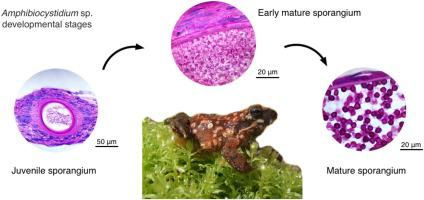Our official English website, www.x-mol.net, welcomes your feedback! (Note: you will need to create a separate account there.)
Developmental stages of Amphibiocystidium sp., a parasite from the Italian stream frog (Rana italica)
Zoology ( IF 2 ) Pub Date : 2020-08-01 , DOI: 10.1016/j.zool.2020.125813 Anna Fagotti 1 , Roberta Rossi 1 , Romina Paracucchi 1 , Livia Lucentini 1 , Francesca Simoncelli 1 , Ines Di Rosa 1
Zoology ( IF 2 ) Pub Date : 2020-08-01 , DOI: 10.1016/j.zool.2020.125813 Anna Fagotti 1 , Roberta Rossi 1 , Romina Paracucchi 1 , Livia Lucentini 1 , Francesca Simoncelli 1 , Ines Di Rosa 1
Affiliation

|
Amphibian parasites of the genus Amphibiocystidium are members of the class Ichthyosporea (=Mesomycetozoea), within the order Dermocystida. Most of the species in the Dermocystida fail to grow in ordinary culture media, so their life cycle has only been partially constructed by studies in host tissues. However, to date, there have been few reports on the life cycle of Amphibiocystidium parasites with respect to the developmental life stages of both Dermocystidium and Rhinosporidium parasites. In this study, we provide light and electron microscopic findings of developmental phenotypes of Amphibiocystidium sp., a parasite previously characterized in the Italian stream frog (Rana italica), which has caused an ongoing infection in a natural population of Central Italy. These phenotypes exhibited distinct morphological characteristics that were similar to A. ranae from the skin of R. temporaria, but showed histochemical properties particularly comparable with those of maturing phenotypes of Rhinosporidium seeberi, and compatible with fungal-like parasites. Therefore, for Amphibiocystidium sp. phenotypes, we suggest adopting the terminology used for maturing stages of R. seeberi, such as juvenile sporangia, early mature sporangia and mature sporangia. The characterization of these developmental stages will be useful to increase the understanding of the life cycle of parasites of the genus Amphibiocystidium and of the interactions with their amphibian hosts.
中文翻译:

Amphibiocystidium sp. 的发育阶段,一种来自意大利河蛙 (Rana italica) 的寄生虫
Amphibiocystidium 属的两栖寄生虫是鱼孢子纲 (= Mesomycetozoea) 的成员,属于皮囊纲。Dermocystida 中的大多数物种无法在普通培养基中生长,因此它们的生命周期仅通过对宿主组织的研究部分构建。然而,迄今为止,关于皮囊虫和鼻孢子虫的发育生命阶段,关于两栖囊虫的生命周期的报道很少。在这项研究中,我们提供了 Amphibiocystidium sp. 发育表型的光学和电子显微镜发现,这是一种以前在意大利河蛙 (Rana italica) 中表征的寄生虫,它在意大利中部的自然种群中引起了持续的感染。这些表型表现出明显的形态特征,与来自 R. temporaria 皮肤的 A.ranae 相似,但显示的组织化学特性特别与成熟的 Rhinosporidium seeberi 表型相当,并且与真菌样寄生虫相容。因此,对于 Amphibiocystidium sp。对于表型,我们建议采用用于 R. seeberi 成熟阶段的术语,例如幼年孢子囊、早期成熟孢子囊和成熟孢子囊。这些发育阶段的特征将有助于增加对两栖类寄生虫的生命周期及其与两栖动物宿主相互作用的理解。但表现出的组织化学特性与成熟的 Rhinosporidium seeberi 表型特别具有可比性,并且与真菌样寄生虫相容。因此,对于 Amphibiocystidium sp。对于表型,我们建议采用用于 R. seeberi 成熟阶段的术语,例如幼年孢子囊、早期成熟孢子囊和成熟孢子囊。这些发育阶段的特征将有助于增加对两栖类寄生虫的生命周期及其与两栖动物宿主相互作用的理解。但表现出的组织化学特性与成熟的 Rhinosporidium seeberi 表型特别具有可比性,并且与真菌样寄生虫相容。因此,对于 Amphibiocystidium sp。对于表型,我们建议采用用于 R. seeberi 成熟阶段的术语,例如幼年孢子囊、早期成熟孢子囊和成熟孢子囊。这些发育阶段的特征将有助于增加对两栖类寄生虫的生命周期及其与两栖动物宿主相互作用的理解。
更新日期:2020-08-01
中文翻译:

Amphibiocystidium sp. 的发育阶段,一种来自意大利河蛙 (Rana italica) 的寄生虫
Amphibiocystidium 属的两栖寄生虫是鱼孢子纲 (= Mesomycetozoea) 的成员,属于皮囊纲。Dermocystida 中的大多数物种无法在普通培养基中生长,因此它们的生命周期仅通过对宿主组织的研究部分构建。然而,迄今为止,关于皮囊虫和鼻孢子虫的发育生命阶段,关于两栖囊虫的生命周期的报道很少。在这项研究中,我们提供了 Amphibiocystidium sp. 发育表型的光学和电子显微镜发现,这是一种以前在意大利河蛙 (Rana italica) 中表征的寄生虫,它在意大利中部的自然种群中引起了持续的感染。这些表型表现出明显的形态特征,与来自 R. temporaria 皮肤的 A.ranae 相似,但显示的组织化学特性特别与成熟的 Rhinosporidium seeberi 表型相当,并且与真菌样寄生虫相容。因此,对于 Amphibiocystidium sp。对于表型,我们建议采用用于 R. seeberi 成熟阶段的术语,例如幼年孢子囊、早期成熟孢子囊和成熟孢子囊。这些发育阶段的特征将有助于增加对两栖类寄生虫的生命周期及其与两栖动物宿主相互作用的理解。但表现出的组织化学特性与成熟的 Rhinosporidium seeberi 表型特别具有可比性,并且与真菌样寄生虫相容。因此,对于 Amphibiocystidium sp。对于表型,我们建议采用用于 R. seeberi 成熟阶段的术语,例如幼年孢子囊、早期成熟孢子囊和成熟孢子囊。这些发育阶段的特征将有助于增加对两栖类寄生虫的生命周期及其与两栖动物宿主相互作用的理解。但表现出的组织化学特性与成熟的 Rhinosporidium seeberi 表型特别具有可比性,并且与真菌样寄生虫相容。因此,对于 Amphibiocystidium sp。对于表型,我们建议采用用于 R. seeberi 成熟阶段的术语,例如幼年孢子囊、早期成熟孢子囊和成熟孢子囊。这些发育阶段的特征将有助于增加对两栖类寄生虫的生命周期及其与两栖动物宿主相互作用的理解。



























 京公网安备 11010802027423号
京公网安备 11010802027423号